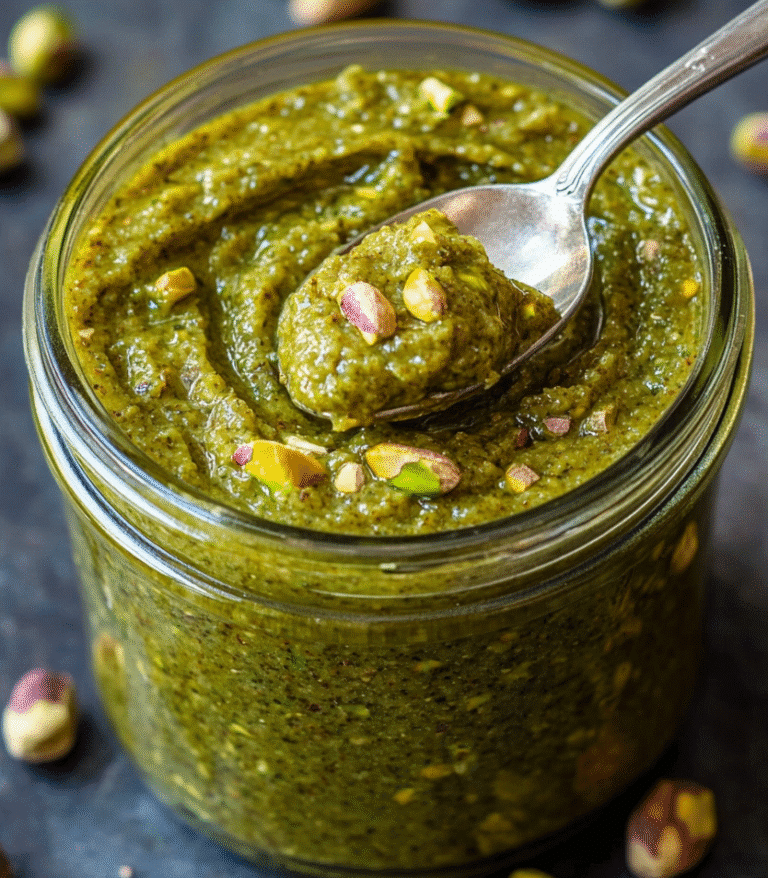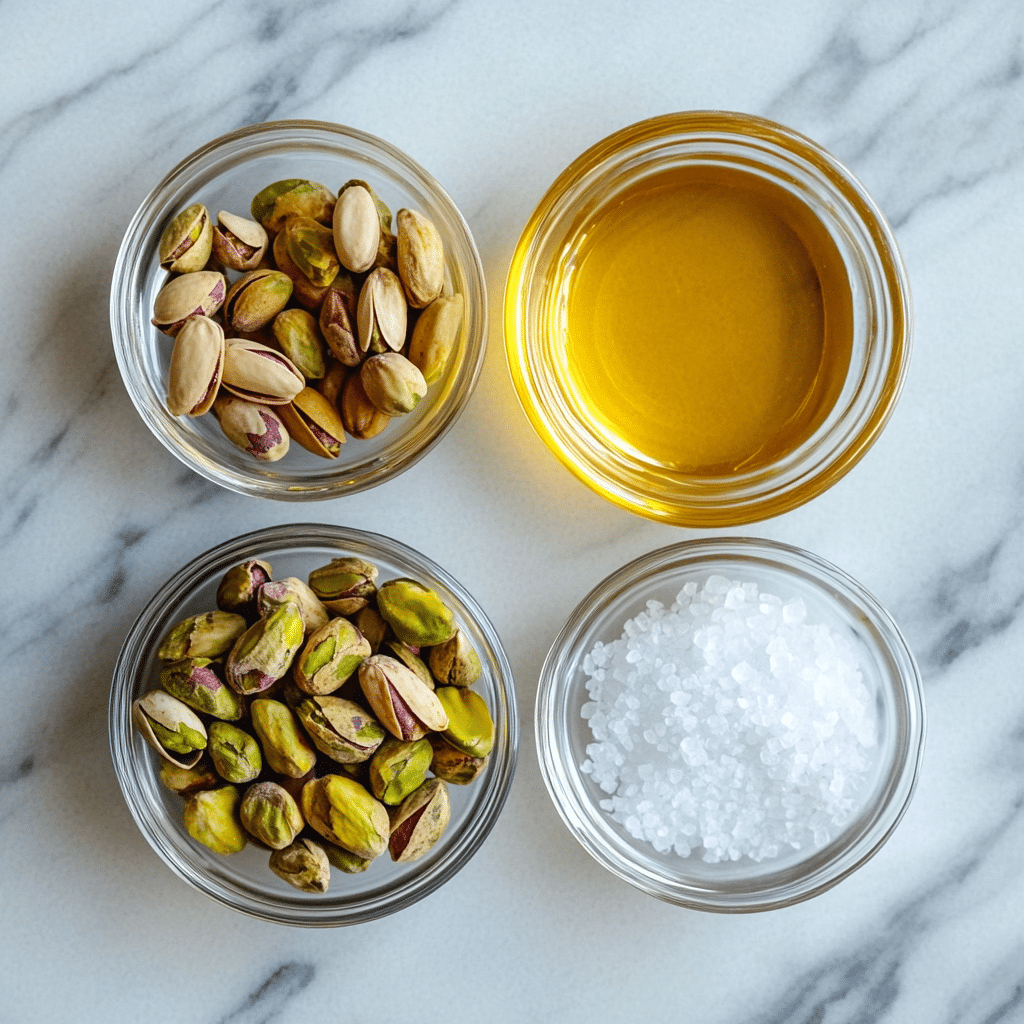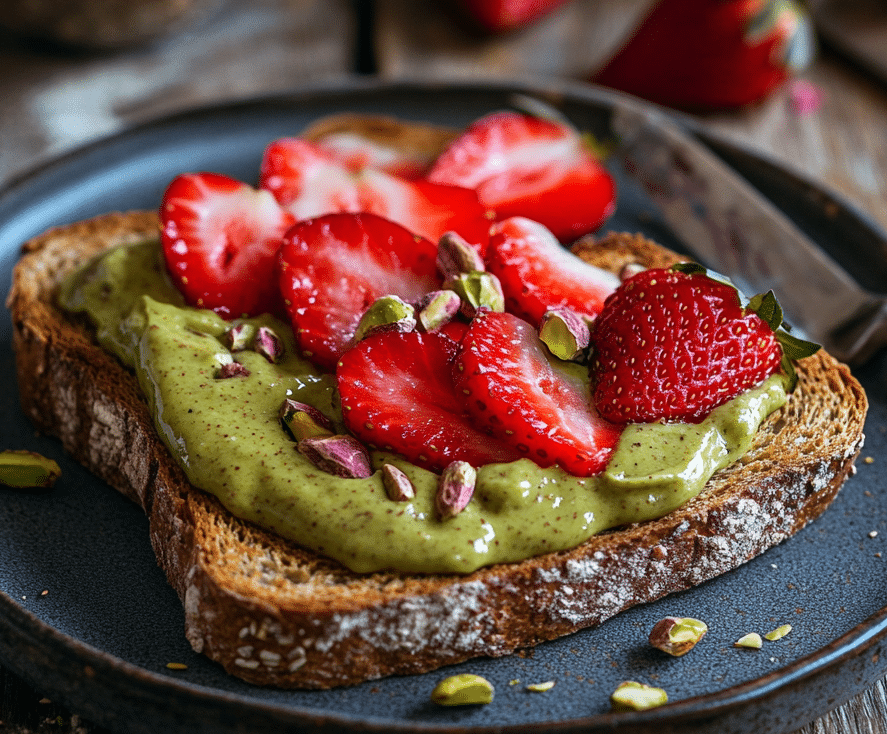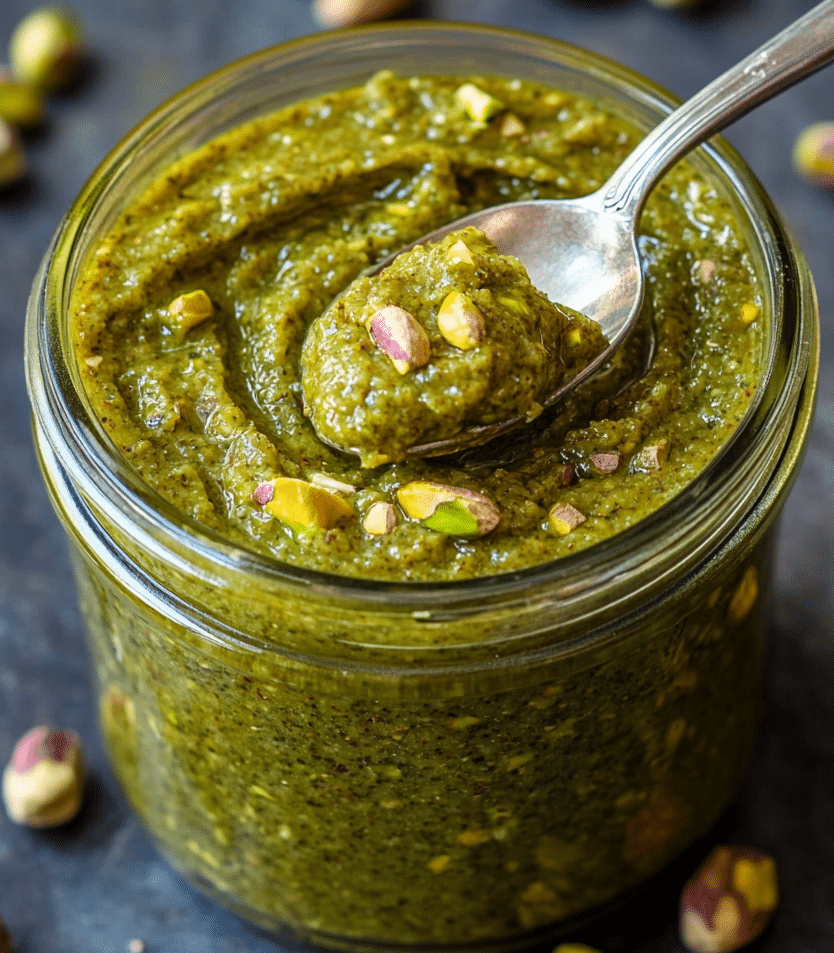Pull up a chair and imagine the moment you first taste pistachio nut butter—the creamy richness, the gentle crunch, the subtle sweetness that isn’t like any other nut spread. In this article, I’ll share where that love for pistachio nut butter began, break down its health perks, compare it with peanut butter, walk you through making it at home, and explore why it comes with a premium price tag. Come with me on this flavorful journey!
Print
Pistachio Nut Butter: Healthy Spread Worth Every Spoonful
Rich, creamy pistachio nut butter made with just a few natural ingredients. Perfect for spreading, blending, or snacking.
- Total Time: 15 minutes
- Yield: 1.25 cups 1x
Ingredients
2 cups raw shelled pistachios
1–2 tbsp neutral oil (like avocado or light olive)
1/4 tsp sea salt (optional)
1 tsp honey (optional)
Instructions
1. Preheat oven to 350°F and spread pistachios on a baking sheet.
2. Roast for 10 minutes until fragrant; cool slightly.
3. Transfer pistachios to a food processor; blend until smooth, 5–8 minutes.
4. Scrape sides as needed; add oil gradually to loosen.
5. Optional: mix in salt and honey for taste.
6. Transfer to a jar and refrigerate up to 3 weeks.
Notes
Use roasted pistachios for richer flavor.
Adjust oil amount for desired creaminess.
Great in smoothies, toast, and desserts.
- Prep Time: 5 minutes
- Cook Time: 10 minutes
- Category: Spreads
- Method: Blended
- Cuisine: American
- Diet: Vegetarian
Nutrition
- Serving Size: 2 tbsp
- Calories: 180
- Sugar: 1g
- Sodium: 40mg
- Fat: 15g
- Saturated Fat: 2g
- Unsaturated Fat: 12g
- Trans Fat: 0g
- Carbohydrates: 6g
- Fiber: 3g
- Protein: 7g
- Cholesterol: 0mg
The Story & Intro to Pistachio Nut Butter
The personal anecdote behind pistachio nut butter
I still remember the first jar of pistachio nut butter I tasted. It was a gift from a friend who brought it back from California—she raved about its vibrant green color and buttery texture. I spread it on toast one sleepy Saturday morning, and that first bite sparked something. The smooth, nutty flavor instantly transported me back to my grandmother’s kitchen, where sharing food meant telling a story. That connection—the way pistachio nut butter brings people together—reminds me why I became a chef in the first place.
Cooking is my craft, but sharing is my passion. At Dishibly, I often reference nut butters like almond and cashew in my recipes, but pistachio nut butter holds a special place. I use it in dressings, baked goods, or simply stirred into Greek yogurt. It’s become a pantry essential.
Why pistachio nut butter stands out nutritionally
Pistachio nut butter isn’t just a flavor bomb—it’s a nutritional powerhouse. It delivers healthy monounsaturated fats, plant-based protein, and gut-friendly fiber in every spoonful. I love knowing that I’m fueling my body with vitamins like B6 and minerals such as magnesium and potassium. Plus, its rich antioxidant content, especially lutein and zeaxanthin, supports eye health.
That balance of nourishment and indulgence is what elevates pistachio nut butter above typical spreads. Whether I’m drizzling it over oatmeal or blending it into smoothies, I value both its taste and nutritional kick. If you’ve explored my almond butter guide or checked out my broader nut spreads section, you know I value quality ingredients—and pistachio nut butter fits right in.
Is Pistachio Nut Butter Healthy?

Health spotlight: Nutritional benefits
Pistachio nut butter packs a serious nutritional punch. With about 7 g of protein and 3 g of fiber per 2‑tablespoon serving, it helps keep you full and energized. It also delivers monounsaturated fats—the kind that supports heart health by helping reduce bad cholesterol. Plus, each spoonful brings essential nutrients like vitamin B6, magnesium, and potassium, all important for energy metabolism and muscle function. Recent studies highlight that these nutrients may help lower blood pressure and support cardiovascular wellness. No wonder I often reach for this butter after an early morning workout or a long day teaching in the kitchen.
Gut health and antioxidant properties
Beyond being a protein‑rich spread, pistachio nut butter supports digestion and fights oxidative stress. Its fiber promotes healthy digestion and gut bacteria balance. Meanwhile, antioxidants—especially lutein and zeaxanthin—help protect cells from damage and support eye health over time. I find it’s a nice swap in my homemade energy balls when I want both flavor and function. If you’ve checked out my nutrition-focused nut butter tips, you know I always choose spreads that nourish inside and out. The antioxidants in pistachio nut butter make it a smart choice for anyone focusing on long-term wellness.
Pistachio vs Peanut Butter—Which Is Better?
Nutritional comparison
Both pistachio nut butter and peanut butter offer solid plant-based nutrition, but they differ meaningfully in their nutrient profiles. Each provides about 7 to 8 grams of protein per 2-tablespoon serving, giving them a strong foundation for muscle support and energy. However, pistachio nut butter delivers a slight edge with more fiber—3 grams compared to peanut butter’s 2. That extra fiber aids digestion and helps you feel full longer, which can support weight management goals.
What sets pistachio nut butter apart is its higher concentration of micronutrients. It’s particularly rich in vitamin B6, which plays a crucial role in brain function, and potassium, which helps regulate blood pressure. Plus, its antioxidant content is significantly higher, thanks to natural compounds like lutein and zeaxanthin that support eye and skin health. If you’re trying to pack more micronutrients into your meals without relying on supplements, pistachio butter is a delicious and effective way to do it.
Peanut butter, by contrast, does offer more niacin (vitamin B3), and it’s often fortified with added nutrients. However, it can contain added sugars, salt, or hydrogenated oils depending on the brand, which may reduce its overall health value unless you’re choosing a natural variety.
Flavor, allergy, and usage differences
Taste is where pistachio nut butter truly shines. It’s smooth, buttery, and subtly sweet with a natural elegance that peanut butter just can’t match. That flavor makes it especially versatile. You can drizzle it over a slice of sourdough, mix it into oatmeal, or even stir it into salad dressings and marinades. It’s equally at home in savory sauces or in baked goods like pistachio blondies or shortbread cookies. I even use it in frostings for a nutty twist on traditional buttercream.
Peanut butter, though deeply familiar and widely loved, tends to dominate a dish with its thick, rich flavor. It’s excellent in sandwiches or paired with chocolate, but it can overpower more delicate ingredients. Pistachio nut butter, with its light profile, enhances rather than overshadows, making it ideal for experimenting in the kitchen.
From a practical standpoint, allergies are a serious consideration. Peanuts are one of the top allergens in the U.S., which means peanut butter may be off-limits in schools or mixed households. Pistachios, while still a tree nut, are far less likely to cause severe reactions and are often considered a safer alternative. If you’re planning recipes for lunchboxes or allergy-aware environments, pistachio nut butter offers flexibility without compromising taste or nutrition.
Ultimately, if you’re looking for a spread that goes beyond basic protein delivery—one that elevates both flavor and function—pistachio nut butter is the clear winner. Whether you’re a parent packing snacks, a home cook exploring new recipes, or simply someone who wants their food to do more, it’s a smart, delicious choice.
Making & Affording Pistachio Nut Butter

How to blend pistachios into butter
Making your own pistachio nut butter is easy and incredibly rewarding. Start with 2 cups of raw, shelled pistachios. Roast them in a preheated oven at 350°F for about 10 minutes, just until they’re lightly golden and fragrant. After cooling slightly, toss them into a food processor. Blend on high speed, stopping to scrape down the sides occasionally. First, they’ll form crumbs, then clumps, and finally transform into a smooth, creamy butter. This can take 5 to 8 minutes depending on your machine.
To adjust the consistency, drizzle in 1 to 2 tablespoons of a neutral oil like avocado or light olive oil. For extra flavor, I sometimes stir in a touch of sea salt or a small spoonful of honey. Store your homemade pistachio nut butter in a clean jar in the fridge—it keeps well for up to 3 weeks. If you’re a fan of making things from scratch, my nut butter DIY section offers even more ways to customize.
Why pistachio butter is expensive
If you’ve ever balked at the price of pistachio nut butter in stores, you’re not alone. Pistachios are one of the priciest nuts because they require very specific growing conditions—mostly found in regions like California, Iran, and Turkey. Add to that the labor-intensive harvesting and shelling process, and it’s no surprise they cost more than peanuts. Pistachios also have a relatively low yield per tree and are in high demand globally.
Store-bought pistachio nut butter reflects all these production factors, plus packaging and distribution markups. But the good news? Making it yourself at home dramatically cuts costs while giving you a purer, fresher spread. If you’re comparing nut spread prices, I’ve laid it out in my nut butter buying guide so you can make informed choices.
for more recipes follow our facebook page
Conclusion
From my grandmother’s cozy kitchen to gourmet markets across the world, pistachio nut butter has come a long way—and I’m thrilled it landed in mine. Whether you’re blending a batch at home or browsing your local store, you now know pistachio butter isn’t just tasty—it’s smart. With its creamy texture, unique flavor, and nutritional depth, it earns its place on your shelf. And if you’re looking for more flavor-packed nut spreads, check out my nut butter collection or swing by the healthy snack recipes section. Now go grab a spoon—or a blender—and taste what this nut butter can do.
Is pistachio nut butter healthy?
Yes, pistachio nut butter is a nutrient-dense choice packed with heart-healthy fats, plant-based protein, and fiber. It also delivers key vitamins like B6 and minerals such as magnesium and potassium. Its antioxidant profile, especially lutein and zeaxanthin, supports eye health. With no added sugars or hydrogenated oils (especially in homemade versions), it’s a wholesome addition to your daily routine.
Is pistachio butter better than peanut butter?
Pistachio butter has a unique edge in terms of nutrition and flavor. While peanut butter offers solid protein, pistachio nut butter contains more fiber and antioxidants, plus a more delicate and naturally sweet taste. It’s also less likely to trigger allergies, making it a great alternative in schools or allergy-aware households.
How to blend pistachios into butter?
To make pistachio nut butter, roast shelled pistachios at 350°F for 10 minutes, then process in a food processor until smooth. The blending takes several minutes and might require a splash of neutral oil to loosen the texture. Add salt or honey for extra flavor if desired. Homemade batches stay fresh in the fridge for up to 3 weeks.
Why is pistachio butter so expensive?
Pistachio butter costs more due to the high price of pistachios themselves. These nuts are labor-intensive to harvest and grow in limited regions. Factor in shelling, low yields, and growing demand, and the price goes up. Making your own pistachio nut butter helps cut costs while maintaining premium quality.

